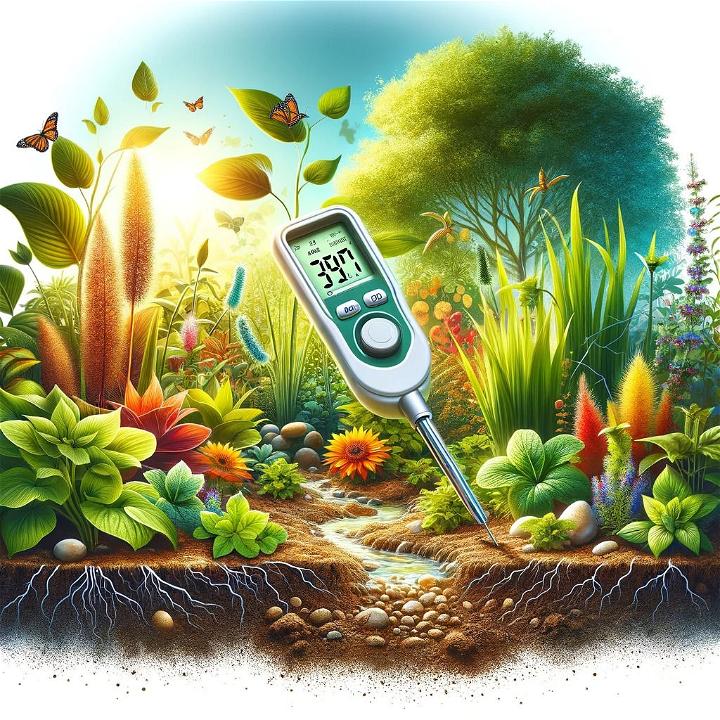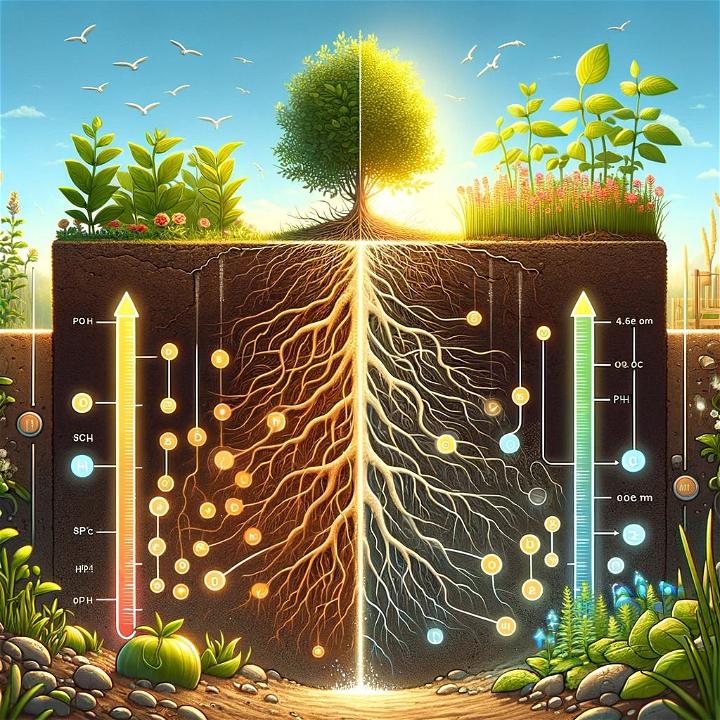Are you struggling with your garden’s soil pH levels? Maintaining the proper pH balance in your soil is crucial for healthy plant growth and thriving crops. By understanding how to raise soil pH effectively, you can create an optimal environment for your plants to flourish.
Different plants require varying soil pH levels for optimal growth. Some may prefer slightly acidic soil, while others thrive in more alkaline conditions. Adjusting the pH level of your soil can be achieved through various methods tailored to specific crops or flowers.
Whether you’re growing vegetables, flowers, or fruits, knowing how to raise soil pH can make a significant difference in your gardening success. By implementing the right techniques, such as using lime, compost, wood ash, or other natural amendments, you can create an ideal pH balance for your plants to absorb nutrients effectively and flourish. Start your journey to healthier, happier plants by mastering the art of adjusting soil pH levels.

Understanding Soil pH
Soil pH plays a crucial role in the health and growth of plants. Understanding the acidity or alkalinity of your soil is essential for successful gardening. The pH scale ranges from 0 to 14, with 7 being neutral. Values below 7 indicate acidity, while values above 7 suggest alkalinity.
Ideal pH Levels for Different Plants
Different plants have varying preferences when it comes to soil pH levels. Understanding these preferences can help you cultivate a thriving garden.
- Acidic-Loving Plants: Plants such as blueberries, azaleas, and rhododendrons thrive in acidic soil with a pH range of 4.5 to 6.
- Alkaline-Loving Plants: On the other hand, plants like lilacs, clematis, and asparagus prefer alkaline soil with a pH range of 7 to 8.5.
It’s crucial to match the pH of your soil to the specific needs of the plants you want to grow. By adjusting the soil pH to meet these requirements, you can promote healthier growth, vibrant blooms, and bountiful harvests.
Ways to Raise Soil pH
Wondering how to adjust your soil’s pH for healthier plants? Here are some effective methods you can use:
Using Lime for pH Adjustment
Lime is a versatile soil amendment that can help raise soil pH levels. There are different types of lime available, such as agricultural lime and dolomitic lime. Agricultural lime is rich in calcium and works well for neutralizing acidic soils, while dolomitic lime contains magnesium in addition to calcium.
When applying lime, it’s crucial to follow recommended practices for optimal results. Start by conducting a soil test to determine the current pH level and calculate the amount of lime needed. Generally, it’s best to apply lime in the fall or early spring to allow it time to break down and adjust the pH before the growing season.
Periodic soil testing is essential to monitor pH changes over time. This way, you can adjust your lime application as needed to maintain the desired pH range for your plants.

Organic Methods for pH Increase
If you prefer organic solutions, there are several approaches to increase soil pH naturally:
- Composting: Creating compost from kitchen scraps, yard waste, and other organic materials can help enrich the soil and raise pH levels. Compost adds beneficial microorganisms and nutrients, promoting a healthy soil environment for plants.
- Mulching: Applying organic mulch like wood chips, straw, or hay helps maintain soil moisture and temperature while gradually releasing nutrients into the soil. Mulching also encourages earthworm activity, which aids in soil aeration and pH balance.
- Natural Amendments: Using natural amendments such as crushed eggshells, gypsum, or wood ash can help elevate soil pH over time. These amendments provide essential minerals that reduce soil acidity and improve nutrient availability for plants.
By incorporating these organic methods into your gardening routine, you can create a sustainable approach to managing soil pH and supporting robust plant growth. Remember to observe your plants’ response to pH adjustments and make ongoing improvements to enhance your garden’s overall health and productivity.
Step-by-Step Guide to Raise Soil pH
Maintaining the correct pH level in your soil is crucial for the health and growth of your plants. Here is a step-by-step guide to help you effectively raise the soil pH:
Testing Soil pH
Before making any adjustments to your soil pH, it’s essential to test it accurately. Soil pH testing kits are reliable tools for this purpose. You can use methods like:
- Soil pH Meter: This is one of the easiest and quickest methods to test your soil’s pH. Simply insert the probe into the soil and get instant results.
- Chemical Test Kits: These kits provide you with a more detailed analysis of your soil’s pH levels. They are easy to use and can be purchased at garden centers or online.
- Saturated Paste Method: This method involves creating a paste with soil and distilled water to measure the pH accurately.
- 1:1 Soil-to-Water Ratio Test: Mix soil and water in a 1:1 ratio to determine the pH level of your soil.
Monitoring and Maintenance
Once you’ve adjusted your soil pH, it’s crucial to monitor it regularly to ensure it stays within the desired range. Here are some tips for monitoring and maintaining soil pH levels:
- Regular Monitoring: Check your soil pH periodically to track any fluctuations and make adjustments as needed.
- Frequency of Adjustments: Depending on your initial soil pH and the desired range, you may need to make adjustments every few months to maintain the ideal pH level.
- Long-Term Management: Consider incorporating organic matter and compost into your soil to stabilize pH levels over the long term.
- Adjustment Methods: To raise soil pH effectively, consider using materials like lime, dolomitic lime, or sulfur to achieve the desired pH range.
By following these steps and monitoring your soil pH regularly, you can create an optimal growing environment for your plants and ensure their health and vitality.
For more detailed information on soil pH testing methods, you can refer to this article on soil pH testing.

Common Mistakes to Avoid
When it comes to raising soil pH, there are common mistakes that gardeners should steer clear of to ensure successful results. Understanding these pitfalls and how to avoid them is crucial for maintaining a healthy environment for your plants.
Overcorrection of pH
One of the most frequent mistakes gardeners make is overcorrecting soil pH. While the goal may be to achieve a specific pH level, excessive adjustments can have detrimental effects on plant health. Overcorrecting can lead to nutrient imbalances, root damage, and hindered plant growth. It’s essential to proceed with gradual adjustments and regularly monitor pH levels to prevent drastic shifts. If overcorrection occurs, remedial actions such as diluting the soil with neutral pH materials or adjusting watering practices can help restore balance.
Ignoring Soil Composition
Ignoring the composition of the soil while focusing solely on pH adjustments is another common misstep. Soil composition plays a significant role in pH stability, and different soil types react differently to pH-altering substances. Clay soils, for example, tend to retain pH adjustments longer than sandy soils. It’s crucial to consider soil texture and structure alongside pH modifications to ensure that the changes made align with the needs of the specific soil type. By recognizing the interplay between soil composition and pH levels, gardeners can make more informed decisions to create an optimal growing environment for their plants.
For more insights on avoiding common mistakes in soil pH management, refer to resources like “Keeping pH in the right range is essential”. Stay informed and cultivate a thriving garden by steering clear of these pitfalls in your soil pH adjustment journey.
FAQs
Here are some frequently asked questions about raising soil pH:
Q: What are the signs that soil pH is too low?
When soil pH is too low, plants may show signs of nutrient deficiencies, such as yellowing leaves or stunted growth. It’s essential to regularly test your soil’s pH to ensure it is within the optimal range for the plants you are growing.
Q: How can I raise the pH of my soil naturally?
One natural way to raise soil pH is by adding agricultural lime, also known as garden lime. This can help neutralize acidic soil and increase the pH over time. Additionally, incorporating organic matter like compost can also help buffer pH levels in the soil.
Q: Can I use vinegar to increase soil pH?
While vinegar is acidic and can lower soil pH, it is not recommended for increasing soil pH. Instead, opt for materials like limestone, wood ash, or agricultural lime to raise the pH of your soil effectively.
Q: How long does it take to see results after raising soil pH?
The time it takes to see results after raising soil pH can vary depending on the method used and the current pH level of the soil. Generally, it may take a few weeks to several months for significant changes in soil pH to reflect in plant health and growth.
Q: What plants benefit from higher soil pH levels?
Plants that prefer alkaline or neutral soil conditions, such as lilacs, clematis, and lavender, thrive in higher pH levels. It’s essential to research the pH preferences of the plants you intend to grow and adjust the soil pH accordingly for optimal growth and health.
Conclusion
In your gardening journey, understanding how to raise soil pH is crucial for the health and productivity of your plants. By following the methods outlined in this guide, you can effectively increase the pH of your soil to create optimal growing conditions for a variety of plants.
Embrace Experimentation
Experimenting with different methods, such as adding organic matter mulch, using finely ground limestone, incorporating wood chips, straw, or compost, allows you to find the best approach for your specific soil type and plant preferences.
Regular Testing and Adjustment
Consistent testing of soil pH is key to monitoring the effectiveness of your pH-raising efforts. Periodic adjustments based on test results ensure that you maintain the desired pH levels for your plants to thrive.
Balance and Patience
Remember that altering soil pH is a gradual process that requires patience and balance. Avoid rapid pH shifts that can shock plants and disrupt their growth. Gradual adjustments and ongoing monitoring yield the best results in the long term.
Sustainable Practices
Incorporate sustainable practices into your soil pH management routine by choosing natural soil amendments and organic materials. This not only benefits your plants but also promotes environmental health and biodiversity in your garden.
Remember, each garden is unique, and the journey to raising soil pH is a rewarding learning experience. Enjoy the process of nurturing your soil and observing the positive impact on your plant life. By implementing these techniques thoughtfully and consistently, you’ll create a thriving garden ecosystem with balanced pH levels that support healthy plant growth.
Explore More About Soil: Relevant Articles and Resources
Discover a wealth of soil-related articles and resources to deepen your understanding of this vital natural resource. Explore more now!
- Phosphorus in Soil: Enhance your garden’s health by learning how to add phosphorus to soil effectively with these practical methods.
- Buying Loam Soil: Discover where to buy loam soil with our detailed guide, perfect for beginners eager to improve their gardening.
- Understanding Topsoil: Uncover the uses and benefits of topsoil for your garden in our comprehensive article on what is topsoil.
- Avoiding Soil Mistakes: Learn crucial tips to sidestep common top soil errors for a lusher, healthier garden in our guide on soil mistakes to avoid.
- Types of Soil Explained: Explore the variety of soils with our in-depth guide, detailing different types of soil for optimal gardening.
- Soil Amendment Tips: Boost your garden’s growth naturally with our insightful soil amendments guide, a must-read for organic gardeners.
- Lowering Soil pH: Discover easy ways to lower soil pH for healthier plant growth, a key for thriving gardens.
- Home Soil pH Testing: Learn how to test soil pH at home with our easy guide, a vital step for garden care.
- Loam Soil Guide: Dive into our ultimate guide on what is loam soil, the ideal choice for many gardeners.
- Soil’s Crucial Role: Understand why soil is important for our ecosystem with our insightful exploration into its vital functions.
- Soil Composition & Functions: Delve into the complexities of soil with our article on what is soil: its composition, types, and key functions.
